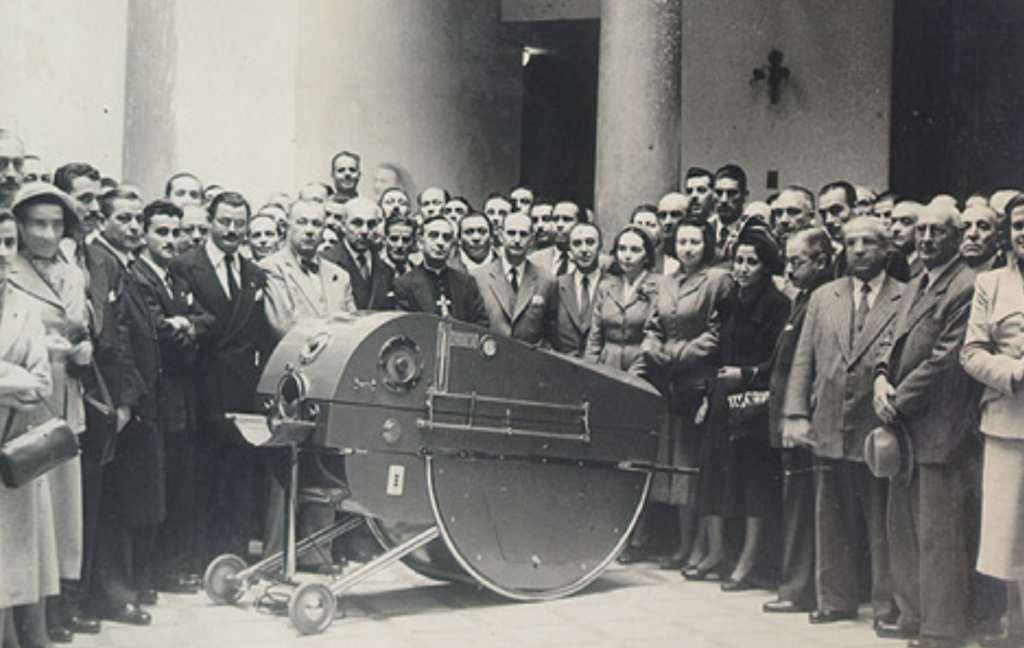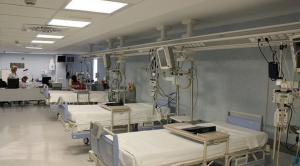—The development of the health industry and new technologies has had huge consequences in the fight against illness over the twentieth and twentieth first century.—
The impact of the health industry and associated health technologies has had an impressive impact on citizens’ life expectancy and control of the body. An important aspect has been the development of technologies capable of replacing diseased or damaged organs or replacing functional deficits through technical actions or external supplements. This was achieved, in the case of diabetes, with the external supply of insulin to alleviate pancreatic deficit, but also in a succession of techniques aimed at replacing the organs damaged by disease or accidents. First was the steel lung, which saved so many polio suffering children from dying of suffocation due to the paralysis of the intercostal muscles that regulate breathing. Later the pacemaker, which regulates cardiac contractions through electric stimulation. Shortly afterwards came renal dialysis and later ventilators or artificial respirators, so essential today in hospital intensive care units. The same idea of intervening in the normal function of organs and tissues is what guides hormone replacement therapy and transplants. They all have one common characteristic: the chemical or mechanical substitution of the activity of an organ or its physical or functional substitution. So-called regenerative medicine, based on tissue banks which are selected by means of genetic compatibility techniques and stem cell cultivation promises a hopeful future but is also ethically and scientifically controversial, due to the power and risks it entails.

Inauguration of the purchase of an “iron lung” invented to prevent asphyxia in patients affected by polio. Wikipedia.
Since the 1970s, hormone replacement therapy has revolutionised contraception methods. The contraceptive pill not only gave women greater freedom to express their sexuality and greater control over procreation, but also reduced birth rates and opened up unprecedented social and employment expectations for women. Shortly afterwards, in the 1980s, in vitro fertilisation and assisted reproduction techniques began, forcing States to establish regulations on the use of human embryos and on the limits of animal cloning techniques. In recent years, the cultivation of pluripotent embryonic cells or adult cells and tissue cultures has promoted new possibilities in the field of regenerative medicine. Its objective is the cultivation and production of tissues compatible with the biological identity of the patient, so that damaged organs and tissues can be recovered through their own or compatible biological materials.
Recently, genome editing techniques have raised new expectations by cutting and replacing DNA sequences that activate or inactivate certain genes associated with specific diseases. No new genes are introduced, but existing ones are modified. This modification is successfully passed on to offspring. This is a technique used in the production of transgenic plants and has been tested on animal and human embryos as well as for the treatment of certain genetic diseases, and cancer. Nanopharmacology also aims to revolutionise the treatment of infectious and oncological diseases. It is based on the use of vectors that transport and release substances into target tissue or cells. These techniques have a promising field of application in the treatment of infectious diseases and tumours. The control of medical technology over the human body has reached levels that were unthinkable only a few decades ago, thanks to molecular diagnosis, genetic identity cards and sequencing technologies. This new scenario has taken disease into the domain of molecular pathology, which will revolutionise the treatment of many hitherto incurable diseases. Artificial intelligence and bionics have also developed artificial limbs and exoskeletons, capable of establishing connections between the central nervous system and the organs and tissues of the human body.

Intensive Care Unit. Teinteresa.es.
On the other hand, from the first decades of the twentieth century, diet and nutrition became essential dimensions in health and social policies. The Universal Declaration of Human Rights left no room for hunger as a cause of death and disease. Strengthened by the devastating effects of the two World Wars and the Great Depression of the 1930s, nutritional science sought to respond to the physiological need for food. The concept of the calorie, a key basic unit for measuring the energy needs of the human body, was first formulated. Then came research focused on nutrients: proteins, fats, carbohydrates, minerals and vitamins. Experimental and clinical research made it possible to assess their metabolic importance and the pathological effects of deficits in the form of deficiency diseases, as well as the process of organ starvation caused by chronic malnutrition. During the Second World War, concentration camps were an excellent space to analyse the pathological effects of hunger on the human organism. Nutritionists then established optimal dietary patterns and minimum diet requirements, which served as a reference for rationing policies in times of war and post-war supply crises. Also to challenge famine in wide poor areas of our planet.

Brazo biónico. Rewisor.com.
Since then, the nutritional properties of food have been analysed and with the impetus of the FAO a Codex Alimentarius was published, and the relationships between diet and certain deficiency diseases or obesity, but also on cardiovascular accidents and cancer, were analysed. The relationship between fat consumption and vegetable insufficiency was associated with cardiovascular accidents, which highlighted the qualities of the Mediterranean diet and its beneficial and protective effects on health. The explosion in the food industry has had its most recent expression in so-called functional foods, enriched with minerals, vitamins or other substances beneficial to health, as well as other foods in which components harmful to the health of certain consumers have been suppressed. Gluten-free or lactose-free products, or products enriched with omega-3 fatty acids, lactobacillus or folic acid are expressions of a new stage in food production. Currently, the food industry and environmentalism reflect the two sides to the global food market: the ability to select industrially improved foods, but also the return to slow food, based on local products.
Josep Lluís Barona Vilar
IILP-UV
How to cite this paper:
Barona Vilar, Josep Lluís. Biopolitics and medical power. Sabers en acció, 2021-02-15. https://sabersenaccio.iec.cat/en/biopolitics-and-medical-power/.
Find out more
You can find further information with the bibliography and available resources.
Recommended reading
Barona Vilar, J.L. Salud, tecnología y saber médico. Madrid: Ed. Fundación Ramón Areces; 2004.
Barona Vilar, J.L. La Medicalización del Hambre. Economía política de la alimentación en Europa. Barcelona: Akal; 2014.
Cooter, R.; Pickstone, J. (eds.) Companion to Medicine in the Twentieth Century. London and New York: Routledge; 2003.
Elias, N. The Civilizing Process. Sociogenetic and Psychogenetic Investigations. Revised edition. Oxford: Blackwell; 2000.
Foucault, M. “L’incorporation de l’hôpital dans la technologie moderne”. In: Dits et écrits. Vol. 2, Paris: Gallimard; 2001, pp. 508-521.
Studies
Barona Vilar, J.L. The Problem of Nutrition. Experimental Science, Public Health and Economy in Europe 1914-1945. Brussels: PIE Peter Lang; 2009.
Barona, J.L.; Bernabeu Mestre, J. La salud y el estado. El movimiento sanitario internacional y la administración española (1851-1945). Valencia: PUV; 2008.
Bernabeu-Mestre, Josep; Barona, Josep L. (eds). Nutrición, Salud y Sociedad: España y Europa en los siglos XIX y XX. Valencia, PUV/Seminar of Studies on Science, 2011.
David, H. (ed.) From Abortion to Contraception: A Resource to Public Policies and Reproductive Behavior in Central and Eastern Europe from 1917 to the Present. Santa barbara: Greenwood; 1999.
Foucault, M. “La naissance de la médecine sociale”. In: Dits et écrits. Vol. 2, Paris: Gallimard; 2001, pp. 207–221.
Hüntelmann, A. C.; Vossen, J.; Czech, H. (eds.) Gesundheit und Staat: Studien zur Geschichte der Gesundheitsämter in Deutschland, 1870 – 1950. Husum: Matthiesen Verlag; 2006.
Laqueur, Th. Making Sex. Body and Gender from the Greeks to Freud. Boston: Harvard University Press, 1992.
Pestre, D. Science, argent et politique. Un essay d’interprétation. Paris, Editions Quae, 2003.
Rodríguez-García, M.; Rodogno, D.; Kozma, L. (eds.) The League of Nations’ Work on Social Issues: Visions, Endeavours and Experiments. Geneva: United Nations Publications; 2016.
Sources
Grande Covián, F. La alimentación en Madrid durante la Guerra Civil (estudio de la dieta suministrada a la población civil madrileña durante diecinueve meses de guerra, agosto 1937 a febrero 1939). Madrid: Publicaciones de la Revista de Sanidad e Higiene Pública; 1939.
Pardo Regidor, A. Segunda Conferencia de Bruselas (1º al 6 de septiembre de 1902) para la profilaxia de la sífilis y enfermedades venéreas, bajo el patronato del gobierno belga. Memoria presentada al Excmo. Ayuntamiento de Madrid por el Delegado del mismo en la citada Conferencia… médico primero por oposición del Beneficencia Municipal. Madrid: Imprenta Municipal; 1904.
Voit, C. von. Food and the Principles of Dietetics. London; 1927.
Wartime rationing and consumption. Geneva, league of Nations, 1942.
World Food Survey. Rome: Food and Agriculture Organization (FAO); 1952.



